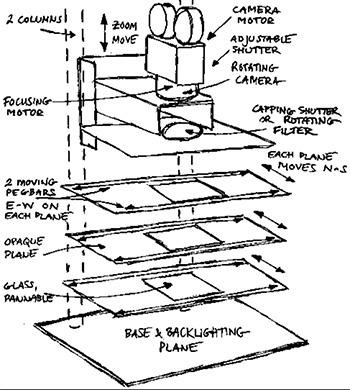Tip #512: Animate With a Multi-Plane Camera
… for Visual Effects
Tip #512: Animate With a Multi-Plane Camera
Larry Jordan – LarryJordan.com
Multiple planes allows changes in depth, focus and perspective.


When photographing traditional cell animation, all elements are painted onto a single cell. The problem is that you can’t create a sense of depth through movement. The multiplane camera fixes this.
First used by Lotte Reiniger for her animated feature The Adventures of Prince Achmed in 1926, the concept was further developed by Ub Iwerks for the Walt Disney Studios in 1933.
The multiplane camera is a motion-picture camera used in the traditional animation process that moves a number of pieces of artwork past the camera at various speeds and at various distances from one another. This creates a sense of parallax or depth.
Various parts of the artwork layers are left transparent to allow other layers to be seen behind them. The movements are calculated and photographed frame by frame, with the result being an illusion of depth by having several layers of artwork moving at different speeds: the further away from the camera, the slower the speed. The multiplane effect is sometimes referred to as a parallax process.
An interesting variation is to have the background and foreground move in opposite directions. This creates an effect of rotation. An early example is the scene in Walt Disney’s Snow White and the Seven Dwarfs where the Evil Queen drinks her potion, and the surroundings appear to spin around her.
The most famous multiplane camera was invented by William Garity for the Walt Disney Studios for the production of Snow White and the Seven Dwarfs. The camera was completed in early 1937. Disney’s multiplane camera, which used up to seven layers of artwork (painted in oils on glass) shot under a vertical and moveable camera, allowed for more sophisticated uses than the Iwerks version and was used prominently in Disney films such as Pinocchio, Fantasia, Bambi, The Adventures of Ichabod and Mr. Toad, Cinderella, Alice in Wonderland, Peter Pan, Sleeping Beauty and The Jungle Book.
EXTRA CREDIT
Here’s a link to Wikipedia to learn more.
Here’s a link to a video of Walt Disney in 1967 illustrating how a multiplane camera works.


Leave a Reply
Want to join the discussion?Feel free to contribute!